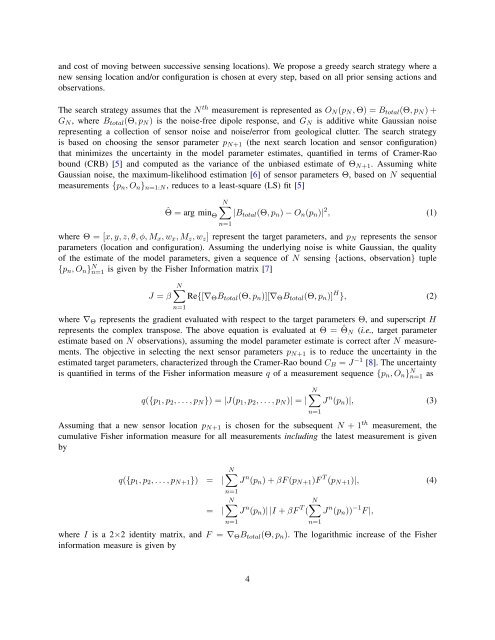INTERIM REPORT - Strategic Environmental Research and ...
INTERIM REPORT - Strategic Environmental Research and ...
INTERIM REPORT - Strategic Environmental Research and ...
Create successful ePaper yourself
Turn your PDF publications into a flip-book with our unique Google optimized e-Paper software.
<strong>and</strong> cost of moving between successive sensing locations). We propose a greedy search strategy where a<br />
new sensing location <strong>and</strong>/or configuration is chosen at every step, based on all prior sensing actions <strong>and</strong><br />
observations.<br />
The search strategy assumes that the N th measurement is represented as O N (p N , Θ) = B total (Θ, p N ) +<br />
G N , where B total (Θ, p N ) is the noise-free dipole response, <strong>and</strong> G N is additive white Gaussian noise<br />
representing a collection of sensor noise <strong>and</strong> noise/error from geological clutter. The search strategy<br />
is based on choosing the sensor parameter p N+1 (the next search location <strong>and</strong> sensor configuration)<br />
that minimizes the uncertainty in the model parameter estimates, quantified in terms of Cramer-Rao<br />
bound (CRB) [5] <strong>and</strong> computed as the variance of the unbiased estimate of Θ N+1 . Assuming white<br />
Gaussian noise, the maximum-likelihood estimation [6] of sensor parameters Θ, based on N sequential<br />
measurements {p n , O n } n=1:N , reduces to a least-square (LS) fit [5]<br />
ˆΘ = arg min Θ<br />
N ∑<br />
n=1<br />
|B total (Θ, p n ) − O n (p n )| 2 , (1)<br />
where Θ = [x, y, z, θ, φ, M x , w x , M z , w z ] represent the target parameters, <strong>and</strong> p N represents the sensor<br />
parameters (location <strong>and</strong> configuration). Assuming the underlying noise is white Gaussian, the quality<br />
of the estimate of the model parameters, given a sequence of N sensing {actions, observation} tuple<br />
{p n , O n } N n=1 is given by the Fisher Information matrix [7]<br />
J = β<br />
N∑<br />
Re{[∇ Θ B total (Θ, p n )][∇ Θ B total (Θ, p n )] H }, (2)<br />
n=1<br />
where ∇ Θ represents the gradient evaluated with respect to the target parameters Θ, <strong>and</strong> superscript H<br />
represents the complex transpose. The above equation is evaluated at Θ = ˆΘ N (i.e., target parameter<br />
estimate based on N observations), assuming the model parameter estimate is correct after N measurements.<br />
The objective in selecting the next sensor parameters p N+1 is to reduce the uncertainty in the<br />
estimated target parameters, characterized through the Cramer-Rao bound C B = J −1 [8]. The uncertainty<br />
is quantified in terms of the Fisher information measure q of a measurement sequence {p n , O n } N n=1 as<br />
q({p 1 , p 2 , . . . , p N }) = |J(p 1 , p 2 , . . . , p N )| = |<br />
N∑<br />
J n (p n )|, (3)<br />
Assuming that a new sensor location p N+1 is chosen for the subsequent N + 1 th measurement, the<br />
cumulative Fisher information measure for all measurements including the latest measurement is given<br />
by<br />
q({p 1 , p 2 , . . . , p N+1 }) = |<br />
= |<br />
n=1<br />
N∑<br />
J n (p n ) + βF (p N+1 )F T (p N+1 )|, (4)<br />
n=1<br />
N∑<br />
N∑<br />
J n (p n )| |I + βF T ( J n (p n )) −1 F |,<br />
n=1<br />
where I is a 2×2 identity matrix, <strong>and</strong> F = ∇ Θ B total (Θ, p n ). The logarithmic increase of the Fisher<br />
information measure is given by<br />
n=1<br />
4

















